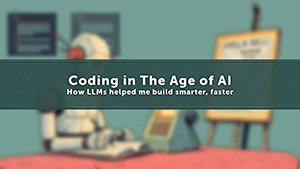
Part of the accessibility series
The beginning. With all its charm and naivety.
I'm sure that my story isn't that different from most that are self-taught. When I began my coding/web development journey years ago I was simply trying to replicate the amazing work that I found, already available, online. I had never taken a coding course. No code, no theory, much less any type of design course. Yet here I was immersing myself in something that I had no business trying to be a part of.
It started as you would expect for the late nineties. Websites were built using HTML tables. CSS wasn't as flexible or as advanced as it is now. Quite a bit of the page styling was even placed inline on the elements being targeted. Terrible, yes. Common at the time, sadly, yes.
As I mentioned, I did not have a design background, so this wasn't about making something flashy or beautiful. This was purely about seeing if I could recreate someone else's work. Something that already was. Not for the purpose of claiming it to be my own mind you but seeing if I could replicate what they had done. Seeing if I could manipulate code and pixels to create something similar to what they were able to create. As most would expect, this involved viewing the source files (pre mainstream GitHub mind you), understanding techniques, looking for common patterns, and seeing if I could find yet another way to accomplish the same task. All to determine if I was skilled enough to end up with a similar front-end look, feel, and experience.
The process wasn't all about viewing source files. There were also countless hours of researching the available resources of the time. Multiple projects begun and abandoned. Unfinished code never to be debugged. Yet, personal designs and styles started to form. Surprisingly, to me, it began to work. I was understanding and absorbing various techniques. Creating what was my own and finding a way to express my personal style in the look and feel of the sites that inspired me. The sites now considered old relics of the web v1.0.Growth
After I became comfortable with the design and structural aspects of my projects, the natural next step, of course, was interactivity. Sure, I could have focused more on refining the very things I was putting aside, but I was looking for "new" knowledge. So, interactivity it was.
What do I mean by interactivity? What did it entail? It could mean almost anything. For my purposes at the time, it was the "simple" things. Submitting forms, "dynamic" data, responding to user interactions in one way or another. Without the breadth of coding background, I started with default form submissions. The default interaction taking a user to a new destination in order to receive their feedback on the submission. In order to try and make it more personal, I took a path that was becoming more and more common – I began investigating JavaScript.
I did what I could to understand the format and methodologies. As I looked further and further into what I wanted to accomplish, I was distracted by the lure of server-side techniques that were more popular at the time. I dove headfirst into Perl/CGI and PHP. My templated content was now able to work and be reused between pages. All the pieces were fitting together, and I would spend my nights and weekends – for years – expanding upon and refining my skills.
But. But that was still providing content and feedback on page load. JavaScript became the focus once again and the new shiny toy was jQuery. jQuery was a great way to expedite the development process and made instant feedback for the user even easier. It was easy enough to connect to API endpoints using "vanilla" JavaScript, but the disparate methods that the various web browsers required and understood could lead to a large amount of duplicative code. All of that aside, the interactivity being embraced by the web as a whole was intriguing.
Everything is awesome
Or was it? While I was on this journey of self-discovery the landscape of web development had been changing. In some ways rapidly. People, designers, businesses, all began to upgrade or update their websites to include the newest techniques. Everyone wanted to remain as current as possible. And it wasn't easy.
Everyone wanted a welcoming interface that would not only be visually appealing to capture the user's attention, but also include content that would keep them engaged. Interfaces became more interactive and engaging. Content ranged from bite sized and informative to in-depth and sprawling. The web was coming alive.
For most of us.
All the shiny
As interfaces advanced and content swelled, users began to learn that they had options. They could find the same or similar information on multiple sites. Through concentrated advertising and early SEO techniques, the leaders began to emerge from the crowd. The mainstream sites if you will.
For all their advances though, there was always something missing from these websites. In fact, from the majority of websites of the day. Oh, they looked great. They worked great. In fact, they grew and became popularized. So much so that once again, they became the thing that burgeoning developers looked to for guidance and the proper way that sites are built.
Unfortunately, for all their advances, most of these websites ignored a significant number of users. Those that only wanted the information. Or simply, an interface that was usable by everyone. Those users that may not even be able to appreciate the website's fantastic interface because they are blind, or otherwise visually impaired. All of the hover animations and niche interaction points are wasted on those users that can't see them, can't click a mouse, or can't interact with them in the same way by using the keyboard alone.
They simply weren't accessible to everyone.
Useful Resources
The Web Content Accessibility Guidelines (WCAG) are a set of technical standards developed by the World Wide Web Consortium (W3C) that help make web content more accessible to people with disabilities. https://www.w3.org/TR/WCAG22/
Google’s inclusive marketing aims to eliminate biases and increase representation in all stages of the creative process to better reflect diverse perspectives. Check out the guides. https://all-in.withgoogle.com/


